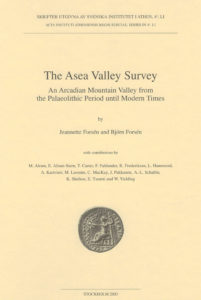 Distributed by Astrom Editions. See record at WorldCat.
Distributed by Astrom Editions. See record at WorldCat.
The Asea Valley Survey. An Arcadian mountain valley from the Paleolithic period until modern times
By Jeannette Forsén & Björn Forsén, with contributions by Michael Alram, Eva Alram-Stern, Tristan Carter, Fredrik Fahlander, Rune Frederiksen, Leslie Hammond, Arja Karivieri, Mika Lavento, Camilla MacKay, Jari Pakkanen, Ann-Louise Schallin, Kim S. Shelton, Eos Tsourti & Wendy Yielding
This volume presents the finds of the Asea Valley Survey (AVS) carried out 1994–1996 in a mountain valley of Arcadia with the acropolis of Asea, the Palaeokastro, as its focal point. During these three seasons of archaeological surface survey 18.7 km2 of the valley were searched intensively in foot. Artefacts spanning from the Middle Palaeolithic period to the early 19th century were systematically collected and documented. Concurrently a geological team gathered data concerning the ever-changing landscape of the valley. By combining new archaeological and geological data with ancient, Byzantine, Ottoman and Venetian written sources the diachronic history of the Asea valley was reconstructed.
Through the discovery of a Middle–Upper Palaeolithic site the regional history has been pushed back to about 50,000 BP. Furthermore, a handful of Early–Middle Neolithic lakeside sites, which produced nothing but chipped stone, may be interpreted as evidence of a gradual Neolithisation of the valley. A rather static settlement pattern, based on three villages, has been documented throughout the Neolithic period and the Bronze Age. From the Neolithic period onwards people of the valley clearly interacted with other regions of the Aegean, possibly in the form of “peer-polity interaction”.
A large amount of data pertaining to the status of Asea as a polis during antiquity, neighbouring Tegea and Pallantion o the east and Megalopolis to the west, has enabled us to interpret Asea in a larger perspective. Data concerning the process of urbanisation, the construction of road networks and the dispersion of isolated farmsteads during the Classical period, as well as of villae rusticate during the Roman period, and the general demographic trends in antiquity are also presented.
Ottoman taxation lists have supplied not only names of long forgotten villages, now archaeologically located by the AVS, but also the numbers of individuals who used to live in these villages, and the ways in which they made their living. The economy of the area witnessed a drastic change at some time during the 17th century, when people turned from a mixed agricultural economy to an economy based on large herds of ovicaprids. It is suggested that this shift may be connected to the dramatic erosion phase of the Medieval–Early Modern period, which was documented by augerings in the surroundings of Asea Paleokastro.
Contents
Acknowledgements
List of illustrations
Abbreviations
1. Introduction and methodology | Jeannette Forsén
2. Previous archaeological research in the Asea Valley | Björn Forsén
3. The geo-archaeological investigation | Mika Lavento
4. The road network of the valley | Björn Forsén
5. Catalogue of sites, with appendices on standing monuments and graves | Jeannette Forsén, Björn Forsén, Mika Lavento, Fredrik Fahlander
6. The prehistoric period | Tristan Carter, Eva Alram-Stern, Jeannette Forsén, Ann-Louise Schallin
7. The Archaic to Hellenistic polis of Asea | Jeannette Forsén, Björn Forsén, Leslie Hammond, Arja Karivieri, Michael Alram, Jari Pakkanen
8. From Roman villas to Medieval and Modern villages | Arja Karivieri, Camilla MacKay, Kim S. Shelton, Tristan Carter, Rune Frederiksen, Björn Forsén
9. General conclusions | Jeannette Forsén, Björn Forsén
Appendix 1. The early travellers—Description and comments | Björn Forsén
Appendix 2. The Asea Hoard of 1938 (IGCH 138) | Eos Tsourti
Appendix 3. Faunal remains from the Asea Valley Survey | Wendy Yielding
Appendix 4. Mortuary data: Structural relations between burials, settlements and the landscape | Fredrik Fahlander
Appendix 5. The administrative structure of the Asea Valley from the 19th century until today | Björn Forsén
General bibliography
Site Index
Bibliographical information
Jeannette Forsén & Björn Forsén, The Asea Valley Survey. An Arcadian mountain valley from the Palaeolithic period until modern times (Skrifter utgivna av Svenska Institutet i Athen, 4°, 51), Stockholm 2003. ISSN 0586-0539. ISBN 978-91-7916-047-0. Hardcover: 378 pages.
Reviews
Annuario della Scuola archeologica di Atene e delle missioni italiane in Oriente 82, 2004:2, 535–546 (F. Longo & A. Santoriello)
Antiquity 80:308, 2006, 470–472 (W.G. Cavanagh)
Gnomon 79:4, 2007, 330–333 (Ulrich-Walter Gans)
Revue Archéologique 2006:2, 415–417 (M. Jost)

No Comments
Comments are closed.